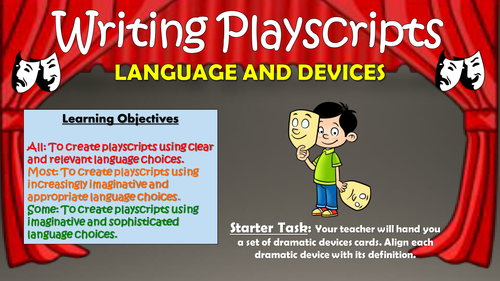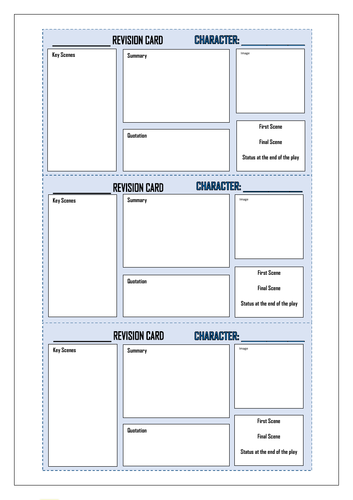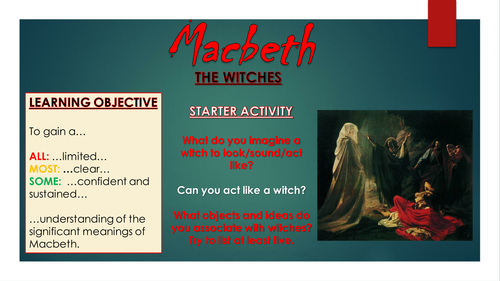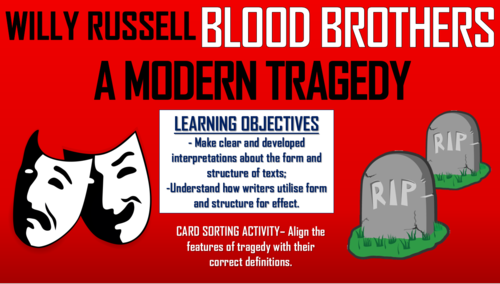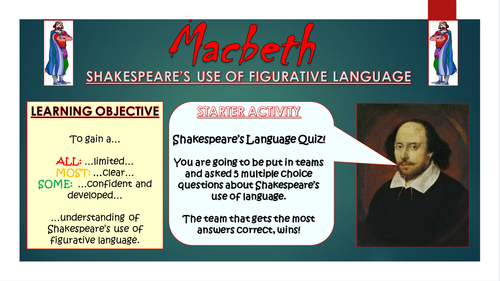
3k+Uploads
1863k+Views
2210k+Downloads
Drama

Writing Playscripts: Language and Devices!
This stimulating and thought-provoking lesson enables students to create playscript texts containing varied and imaginative dramatic language and devices, using techniques appropriately to engage audiences. In particular, students learn how key features such as dramatic irony, dramatic tension, pauses, hesitations, and stage directions can aid the creation of original and engaging playscripts.
The lesson follows a clear, logical, bite-size learning journey, which guides students towards differentiated learning objectives. Over the course of this journey, they become able to:
- Define and exemplify the key language devices of playscripts;
- Identify the key features within an extract of an existing playscript, commenting upon effect;
- Gaining an in-depth understanding of the application of some of the more complicated language features;
- Completing short, fun, application tasks to check their understanding;
- Write their own playscripts, with accurate language and devices;
- Self/Peer assess their playscript attempts.
This resource pack includes:
- A visually engaging whole-lesson PowerPoint presentation;
- An engaging and appropriate playscript extract to learn from;
- Cards for the card-sorting task;
- An analysis worksheet;
- A detailed lesson plan, complete with what the teacher and students should aim to achieve at each stage of the lesson.
All images are licensed for commercial use, and are cited on the final slide of the PowerPoint.

English Revision Cards Blank Templates - for Plays
These colouful and well-structured card templates are designed to aid student revision of key topic areas. They can be filled in by either students or teachers, and then used by incorporating them into revision games, as essay writing aids, or as home revision aids. They are provided as both PDFs (to prevent formatting issues between computers) and as Word documents (for easy editing). They simply need to be cut out (if printed on card) and laminated (if printed on paper). This particular pack is intended for the revision of plays, and includes cards to aid the revision of:
Characters
Context
Devices
Scenes
Themes
I’ve also included an model example of how to fill the cards out, using characters from Macbeth.
For any questions or comments, please contact TandLGuru@yahoo.co.uk - Many thanks!

Much Ado About Nothing - Shakespeare's Dramatic Devices!
This engaging, in-depth lesson enables students to understand how Shakespeare uses a range of dramatic devices for effect within ‘Much Ado about Nothing.’ In particular, the lesson focuses upon the dramatic irony and tension used to build the themes of confusion and deception. A close analysis of Act II Scene I: The Masquerade Ball, is included, to exemplify the impact of the dramatic devices upon Shakespearean audiences.
The lesson follows a step-by-step learning journey, in which students learn through:
- Defining and exemplifying the key dramatic devices;
- Relating key dramatic devices to the themes of confusion and deception;
- Reading and comprehending the predominant plot events in Act II Scene I.
- Completing an essay style response in which they consider how dramatic devices help to create Shakespeare's intended effects upon audiences.
- Peer assessing each other's learning attempts.
Included is:
- Whole lesson PowerPoint - colourful and detailed - just download and teach from it!
- Cards for card-sorting activity;
- Confusion and Deception worksheet (and teacher answer sheet);
- Act II Scene I analysis sheet
- Analysis template with success criteria for creating well-structured responses;
- Comprehensive lesson plan.

Macbeth: The Witches
This engaging and informative lesson enhances students' skills in understanding the significant meanings in William Shakespeare's Macbeth, and in particular the influence of the deceitful and mysterious weird sisters. Students gain an understanding of some of the attitudes towards witches in Shakespeare's times, and attempt to link this knowledge to the events of the text. They also engage with Shakespeare's intentions in utilising dramatic elements to reveal the witches use of the supernatural and deceit.
The lesson follows a clear and logical learning journey, involving progressively more challenging tasks in which students:
- Portray their understanding of witches and witchcraft;
- Learn more about witches in a historical context through a fun 'true or false' game;
- Define, identify, and understand dramatic irony;
- Read sections of Macbeth and complete tasks to demonstrate their understanding;
- Answer key questions about the witches that test their knowledge in relation to each of the English assessment outcomes;
- Evaluate a modelled example of an analytical paragraph in relation to the witches;
- Analyse the witches' characteristics in their own responses;
- Evaluate each others' analytical responses.
All images are cited on the final slide of the presentation, and are licensed for commercial use.
Bundle Sale

Writing Playscripts Lesson Bundle!
These engaging and detailed resources have been designed to make the writing of playscripts exciting, interesting, and easily accessible for all children. Throughout each lesson, students consider a different element of their writing (content, language, and structure) in order to produce imaginative and appropriate playscripts. Each lesson contains a comprehensive whole lesson PowerPoint, all the resources that you will need, and a detailed lesson plan.
Included are the following lessons:
1. Writing Playscripts: Interesting Subject Matter
2. Writing Playscripts: Language and Devices
3. Writing Playscripts: Structure and Organisation
All images are licensed for commercial use, and are cited on the final slide of the PowerPoint/ the bottom of worksheets.

Blood Brothers - A Modern Tragedy
This engaging and interesting lesson enables students to make clear and developed interpretations regarding the form and structure of Willy Russell’s Blood Brothers. In particular, students learn about the key features of tragedies, identify these in the play, and analyse their effectiveness, considering Russell’s intentions.
The lesson utilises a range of tasks, that require students to be both independent and collaborative learners. It follows this learning journey:
Defining and exemplifying each of the features of tragedies;
Inspecting the play, identifying and analysing Russell’s use of the features of tragedies throughout;
Understanding the writer’s intentions and the anticipated audience reactions through some of the features of tragedies;
Creating a mind map demonstrating the effectiveness of the features of tragedy upon the audience;
Applying their understanding of the features of tragedy in the play to a storyboarding activity;
Self-evaluating their learning in the lesson.
Included in this resource pack are:
A well-presented, thorough, and informative, whole-lesson PowerPoint presentation;
Features of tragedy cards for the card-sorting activity;
‘Text Inspector’ worksheet for the identification task;
Template for the storyboarding activity;
A comprehensive teacher guidance form/lesson plan to assist delivery.
Resources are provided in both Word (for easy editing - find in the zip file)and PDF (to prevent formatting issues between computers).
All images in this resource are licensed for commercial use, and are cited on the final slide of the lesson presentation.
Bundle Sale

The Woman in Black Lesson Bundle!
This engaging, varied, and informative scheme of learning is designed to help students gain understanding, assessment skills, and key interpretations of Susan Hill’s ghost story ‘The Woman in Black.’ Made up of a wide-range of interesting and exciting lessons, students should complete this scheme having gathered vital skills in: interpreting the significant meanings of the text, understanding the writer’s ideas within the text, analysing key characters, settings, and themes, and understanding Hill’s language devices.
Stimulating, visual, and easily adaptable, these lessons provide suggested learning objectives and outcomes for students of a wide-range of abilities - The vast majority of tasks are differentiated to allow for different abilities and needs in your classroom. Each lesson loosely follows this logical learning journey to ensure that students learn in bite-size steps:
- Engaging
- Defining/ Understanding
- Identifying/Remembering
- Analysing/ Creating
- Peer or self evaluating.
All of the lessons are interactive, employ a variety of different teaching and learning methods and styles, and are visually-engaging. Resources, worksheets, and lesson plans are all provided.

Writing Playscripts: Interesting Subject Matter!
This stimulating and thought-provoking lesson enables students to create playscript texts containing appropriate and imaginative content choices, using knowledge of genre and narrative structure to form engaging subject matter. In particular, students learn how key features such as the setup, confrontation, and resolution, in addition to characters (such as heroes and villains) can aid the creation of original and engaging playscripts.
The lesson follows a clear, logical, bite-size learning journey, which guides students towards differentiated learning objectives. Over the course of this journey, they become able to:
- Define and exemplify the different genres of playscripts;
- Research and identify the key features of different genres;
- Gaining an in-depth understanding of the narrative structure of playscripts;
- Applying this understanding to popular playscripts, and then using this information to create their own playscripts;
- Write their own playscripts, with interesting, varied, and appropriate subject matter;
- Self/peer assess their playscript attempts.
This resource pack includes:
- A visually engaging whole-lesson PowerPoint presentation;
- A helpful and well-structured research template;
- A comprehensive planning sheet for designing their own playscripts;
- A detailed lesson plan, complete with what the teacher and students should aim to achieve at each stage of the lesson.
All images are licensed for commercial use, and are cited on the final slide of the PowerPoint.
Bundle Sale

Macbeth: Lesson Bundle! (All Lessons, Plans, Resources, Everything!)
This engaging, varied, and informative scheme of learning is designed to help students gain understanding, assessment skills, and key interpretations of William Shakespeare's tragedy 'Macbeth.' Made up of a wide-range of interesting and exciting lessons, students should complete this scheme having gathered vital skills in: interpreting the significant meanings of the text, understanding the writer's ideas within the text, identifying the traits of key characters, settings, and themes, understanding dramatic and language devices, and relating the text to its social and historical context.
Stimulating, visual, and easily adaptable, these lessons provide suggested learning objectives and outcomes for students of a wide-range of abilities - The vast majority of tasks are differentiated to allow for different abilities and needs in your classroom. Each lesson loosely follows this logical learning journey to ensure that students learn in bite-size steps:
- Engaging
- Defining/ Understanding
- Identifying/Remembering
- Analysing/ Creating
- Peer or self evaluating.
All of the lessons are interactive, employ a variety of different teaching and learning methods and styles, and are visually-engaging. Resources, worksheets, and lesson plans are all provided, in addition to a fun Pointless game!

The Woman in Black: Jennet Humfrye and Nathaniel Drablow!
This engaging and informative lesson enables students to make precise and sustained interpretations regarding the sub-plot of Jennet Humfrye and Nathaniel Drablow in The Woman in Black. Through close analysis of extracts of the sub-plot, they consider how the woman in black herself came to being, and learn her ghastly purpose.
The lesson follows a step-by-step learning journey, in which children learn through:
- Reading and understanding the sub-plot of Jennet Humfrye and Nathaniel Drablow;
- Understanding and comprehending the key themes and ideas raised in the sub-plot;
- Empathising and evaluating the sub-plot, arguing a viewpoint on behalf of a character;
- Analysing how Hill utilises the sub-plot to aid and develop the wider story;
- Peer assessing each other's learning attempts.
Included is:
- Whole lesson PowerPoint - colourful and comprehensive;
- Extracts from 'The Woman in Black' which details the sub-plot;
- 'Jennet Humfrye and Nathaniel Drablow' worksheet (and answer sheet for teachers);
- Empathy Footprints for 'In Your Shoes' task;
- Analysis template with success criteria for creating well-structured responses;
- Comprehensive lesson plan.
There are also opportunities for group learning, peer assessment, and whole class discussion. This was originally taught to mixed ability year 10 groups, but can easily be differentiated for groups of different ages and abilities.
All images are licensed for commercial use, and image rights are listed on the last page of the presentation.

Macbeth: Act 2 Scene 2 - The Murder of King Duncan!
This lesson aims to improve students’ understanding of one of the key scenes in William Shakespeare’s Macbeth – Act II Scene II. In particular, they learn to make insightful interpretations about Shakespeare’s use of symbolism, and are enabled to understand how this would have affected Shakespearean audiences.
The lesson utilises a range of tasks, that require students to be visual and interactive learners. It follows this learning journey:
- Defining the key term 'symbolism' and establishing its importance as a literary technique;
- Understanding the different objects that were used as symbols in Shakesperean times through a multiple choice team game;
- Reading and interpreting Act 2 Scene 2, and establishing how symbolism is utilised throughout;
- Summarising the events of the scene;
- Analysing Shakespeare's intentions in using literary techniques, and considering the audience reactions to them;
- Peer/self evaluating the learning in the lesson.
Included in this resource pack are:
- A well-presented, thorough, and informative, whole-lesson PowerPoint presentation;
- Resources for the reading and interpreting activity - full scene transcript with space for notes;
- A template to help scaffold the main task, complete with P.E.E instructions;
- A comprehensive teacher guidance form/lesson plan to assist delivery.
All images in this resource are licensed for commercial use, and are cited on the final slide of the lesson presentation.

Macbeth: Shakespeare's Figurative Language!
This interesting and stimulating lesson aims to improve students’ understanding of Shakespeare’s use of figurative language in Macbeth, focusing particularly on similes, metaphors, personification, hyperbole, and euphemisms. Students learn to analyse the intended effect of these devices through a close-reading and interpretation of Act 5 Scene 1: The sleepwalking scene involving Lady Macbeth.
The lesson utilises a range of tasks, that require students to be visual and interactive learners. It follows this learning journey:
- Defining the key term 'figurative language' and establishing its importance as a literary technique;
- Defining and exemplifying each of the key terms 'simile, metaphor, personification, hyperbole, and euphemisms through collaborative group opportunities;
- Understanding how and why figurative language is used to add depth to writers' ideas;
- Reading and interpreting Act 5 Scene 1, and establishing how figurative language impacts upon the scene;
- Reflecting upon why this may/ what effect this may have had on audiences at the time;
- Summarising the events of the scene;
- Peer/self evaluating the learning in the lesson.
Included in this resource pack are:
- A well-presented, thorough, and informative, whole-lesson PowerPoint presentation;
- Resources for the reading and interpreting activity - full scene transcript with space for notes;
- A template to help scaffold the main task, complete with P.E.E instructions;
- Cards for the card sorting group activity
- A comprehensive teacher guidance form/lesson plan to assist delivery.
All images in this resource are licensed for commercial use, and are cited on the final slide of the lesson presentation.
Bundle Sale

Much Ado About Nothing: Lesson Bundle! (All Lessons, Resources, Plans, Everything!)
This engaging, varied, and informative scheme of learning is designed to help students gain understanding, assessment skills, and key interpretations of William Shakespeare’s tragedy ‘Much Ado About Nothing.’ Made up of a wide-range of interesting and exciting lessons, students should complete this scheme having gathered vital skills in: interpreting the significant meanings of the text, understanding the writer’s ideas within the text, identifying the traits of key characters, settings, and themes, understanding dramatic and language devices, and relating the text to its social and historical context.
Stimulating, visual, and easily adaptable, these lessons provide suggested learning objectives and outcomes for students of a wide-range of abilities - The vast majority of tasks are differentiated to allow for different abilities and needs in your classroom. Each lesson loosely follows this logical learning journey to ensure that students learn in bite-size steps:
- Engaging
- Defining/ Understanding
- Identifying/Remembering
- Analysing/ Creating
- Peer or self evaluating.
All of the lessons are interactive, employ a variety of different teaching and learning methods and styles, and are visually-engaging. Resources, worksheets, and lesson plans are all provided.
Bundle Sale

GCSE Revision Cards Big Bundle!
These colourful, comprehensive, and well-structured revision cards have been creatively designed for students securing their understanding of:
-Animal Farm;
-Macbeth;
-Romeo and Juliet;
-A View from the Bridge.
Each card is visually-appealing and highly-detailed, covering aspects of each feature including a full summary, cited quotations from the play, definitions/ examples, and a consideration of audience reactions. They are tried and tested, with teachers incorporating them in revision games, using them as essay writing aids, or utilising them as home revision aids. They are provided as both PDFs (to prevent formatting issues between computers) and as Word documents (for easy editing).
The packs contain revision cards on each of the main: Characters, Features of Context, Events, Themes, and Devices.
I have also included the revision cards templates so that you can create your own!
For any questions or comments, please contact TandLGuru@yahoo.co.uk - Many thanks!
Bundle Sale

Blood Brothers Lesson Bundle!
This engaging, varied, and informative scheme of learning is designed to help students gain understanding, assessment skills, and key interpretations of Willy Russell’s play ‘Blood Brothers.’ Made up of a wide-range of interesting and exciting lessons, students should complete this scheme having gathered vital skills in: interpreting the significant meanings of the text, understanding the writer’s ideas within the text, identifying the traits of key characters, settings, and themes, understanding dramatic and language devices, and relating the text to its social and historical context.
Stimulating, visual, and easily adaptable, these lessons provide suggested learning objectives and outcomes for students of a wide-range of abilities - The vast majority of tasks are differentiated to allow for different abilities and needs in your classroom. Each lesson loosely follows this logical learning journey to ensure that students learn in bite-size steps:
Engaging
Defining/ Understanding
Identifying/Remembering
Analysing/ Creating
Peer or self evaluating.
All of the lessons are interactive, employ a variety of different teaching and learning methods and styles, and are visually-engaging. Resources, worksheets, and lesson plans are all provided.

